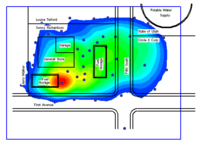GMS:2D Scatter Point Set Creation and Editing
Each of the points from which values are interpolated are called scatter points. A group of scatter points is called a scatter point set. Each of the scatter points is defined by a set of xy coordinates.
Each scatter point set has a list of scalar datasets. Each dataset represents a set of values which can be interpolated to a TIN, mesh, or grid.
Multiple scatter point sets can exist at one time in memory. One of the scatter point sets is always designated as the "active" scatter point set. Interpolation is performed from the active dataset of the active scatter point set only.
Contents
Creating Scatter Points
Scatter point sets can be created in one of three ways: interactively creating scatter points, converting from other data types, or importing from a file.
Interactively Creating Scatter Points
The Create scatter point tool is used to click out new scatter points in the GMS Graphics Window. The new scatter points are added to the active scatter point set. If wanting the new points in their own scatter point set, select the Scatter Points | New Scatter Point Set command.
Converting from Other Types
Scatter point sets are often created by converting from other data types (TINs, meshes, grids, boreholes). The following commands are available to convert an object to a scatter point set:
Importing Tabular Scatter Point Data
In most cases, scatter point sets are created by importing a text file through the File Import Wizard.
Editing Scatter Points
The location of a scatter point can be edited by selecting the scatter point and dragging it to a new location or by typing in the new coordinates in the Edit Window.
The dataset value associated with a scatter point can be edited using the edit field labeled "F:" in the Edit Window. Dataset values can also be edited using a spreadsheet dialog by selecting the Edit Values button in the Dataset Info dialog.
In addition to the dataset values, each scatter point has three properties that can be edited on a point by point basis:
- label
- material
- Fixed pilot point
The label is a text string that can be displayed by turning on the ID option in the Display Options dialog. The material type is used for indicator simulations.
The fixed pilot point property is used with PEST(See Automated Parameter Estimation). If this option is on, then the value at this point is not estimated during the parameter estimation process.
The scatter point properties can be edited by double-clicking on a point or by selecting a set of points and selecting the Properties command in the Edit menu.
Deleting Scatter Points
Individual scatter points can also be deleted. This command results in the removal of the point from all the datasets associated to the scatter point set.
| [hide]GMS – Groundwater Modeling System | ||
|---|---|---|
| Modules: | 2D Grid • 2D Mesh • 2D Scatter Point • 3D Grid • 3D Mesh • 3D Scatter Point • Boreholes • GIS • Map • Solid • TINs • UGrids | |
| Models: | FEFLOW • FEMWATER • HydroGeoSphere • MODAEM • MODFLOW • MODPATH • mod-PATH3DU • MT3DMS • MT3D-USGS • PEST • PHT3D • RT3D • SEAM3D • SEAWAT • SEEP2D • T-PROGS • ZONEBUDGET | |
| Aquaveo | ||
